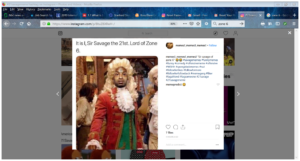What are they?
Meme. The word itself sounds sort of droll, minted by pop culture people and certified by Merriam-Webster for our social media purposes. Memes pop up on our Instagram Explore, Twitter and perhaps Facebook feeds, and are characterized by having captions above or superimposed over photos from pop culture.
What is it about memes that make them so effortlessly appealing?
Perhaps their undeniable ability to elicit feelings of relatability and amusement. As social media is becoming increasingly popular for spreading news, memes can shed light on current events. They are also a good way to fuel your desire to procrastinate when you have an especially tricky p-set that you can’t even begin to think about working through. Most of all, they can help you connect with people, especially on this blessed campus where we are fortunate enough that we can find peers with such compatible, wacky senses of humor. In an age where we pride ourselves on speed, memes are an efficient way to get a quick comedic fix during the epic speed-walking and biking we pull off in 10-minute class changes. You also come across memes when you scold yourself for your lack of sleep but can’t help double-tapping or favorite-ing a couple in the comfort of your twin extra-long before really hitting the sack.
There are trends within memes as well, whether it be through the form in which the captions are styled or the photos/GIFs used for the visual component. Common themes that emerge in contemporary meme culture include those of an inability to understand what the heck is going on, being “done” with something or someone, relatable twists from modern-day romance and wack events. During the past year, the most popular meme formats have included:
- Celebrity full names

- The “don’t say it”
- Kermit sipping tea
- The Young Thug/Lil Durk

- The “thank u, next” courtesy of Ariana Grande
- “Mine” courtesy of Bazzi
- The squinting woman with her hands on her knees

- AirPods and waves
Memes can also be a source of controversy. As an example of memes being affected by contemporary culture, we can reference the abundance created in light of 21 Savage’s unexpected detention by ICE due to his alleged overstaying of his visa — Savage is a British citizen. Although these memes are amusing in the sense that they highlight the public’s surprise at Savage’s true nationality, they show how stringent and life-altering ICE policies can be, pushing for changes in said policies. To give another instance, a few years ago, the meme of Pepe the Frog became associated with the alt-right movement.

The popularity of memes on campus must not go amiss. There is the Facebook page called “Memes for Edgy Trees,” populated by Stanford-related memes. Additionally, there is @jroastie, ostensibly run by residents of freshman dorm Junipero, or J-Ro. A page that boasts more than 12 million followers on Instagram, including numerous celebrities, is that of @daquan. Memes can be catered to their audiences, and these pages are clear evidence of that.
Memes’ purposes are manifold and provide a place for us to temporarily escape the 21 units and five extracurricular activities in which we participate. We can take comfort in finding some weird, human joy through captioned images created by other people who have the same thoughts and senses of humor as we do. Sometimes it’s the caption and sometimes it’s simply the facial expression of the individuals in the associated photo. In the end, the vehicle really doesn’t matter, but the way memes make you feel does.
Contact Sarayu Pai at smpai918 ‘at’ stanford.edu.